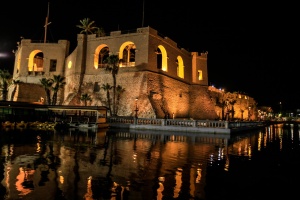By Mohamed Abaid
Understanding and Addressing Smuggling in Libya

Smuggling in Libya is driven by a combination of factors, including economic disparity, political instability, and the strategic geographical location of the country. The economic disparity between Libya and its neighboring countries, particularly those in Sub-Saharan Africa, creates a strong incentive for people to engage in smuggling activities. The political instability following the 2011 uprising has created a power vacuum, allowing smuggling networks to operate with relative impunity.
Moreover, Libya's strategic location, with its extensive coastline and proximity to Europe, makes it a major transit point for smuggling, including human trafficking and drug smuggling. The lawlessness in certain parts of the country provides a conducive environment for these illicit activities to thrive.
Smuggling Routes
Smuggling routes in Libya are often complex and adaptable, changing in response to law enforcement activities and other factors. A significant amount of smuggling activity occurs in the vast desert areas of the country, where monitoring and enforcement are challenging. The town of Murzuq, located about 350 km from Libya's southern border, has been identified as a key point in many smuggling routes. From there, convoys of vehicles often head north unhindered.
The Central Mediterranean Sea route is another major pathway for smuggling, particularly for human trafficking. This route is considered the most dangerous crossing for irregular migrants in the world, with over half a million potential migrants waiting in Libya at any given time to travel to Italy with the aid of human smugglers.
Solutions
Strengthening Law Enforcement: Enhancing the capabilities of law enforcement agencies, including border security forces, is crucial. This could involve providing better training, equipment, and resources to detect and intercept smuggling activities.
Political Stability: Achieving political stability in Libya is a key step towards curbing smuggling. A stable government can enforce laws more effectively, provide better services to its citizens, and work with international partners to address smuggling.
Economic Development: Addressing economic disparity through development initiatives can reduce the incentive for people to engage in smuggling. This could involve creating job opportunities, improving infrastructure, and promoting investment in Libya.
International Cooperation: International Smuggling is a transnational issue that requires international cooperation to address effectively. This could involve sharing intelligence, coordinating law enforcement activities, and working together on initiatives to address the root causes of smuggling.
Addressing the Demand: Finally, efforts should be made to address the demand side of smuggling, particularly for human trafficking. This could involve raising awareness about the dangers of smuggling, providing support to vulnerable populations.
Conclusion: The issue of smuggling in Libya is complex and deeply rooted in the country's socio-economic fabric. While the situation remains challenging, there are potential solutions that, if implemented effectively, could help curb smuggling activities and their negative impacts. These solutions require a comprehensive approach that addresses the root causes of smuggling, including political instability, economic challenges, and security issues. It is crucial for the international community to support Libya in these efforts to ensure a stable and prosperous future for the country and its people.
Disclaimer: The views and opinions expressed in this article are those of the writer, and do not necessarily reflect those of the Libya Observer






